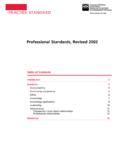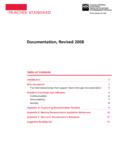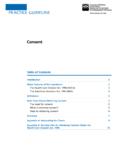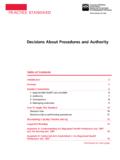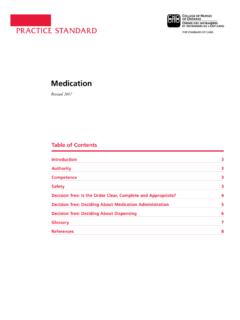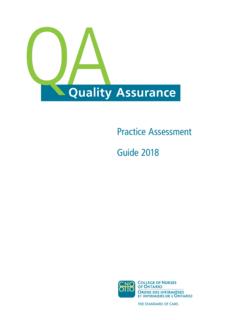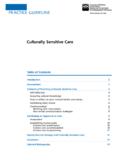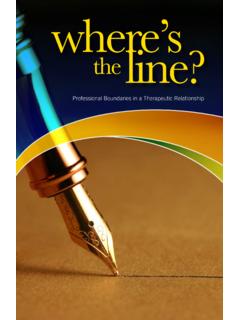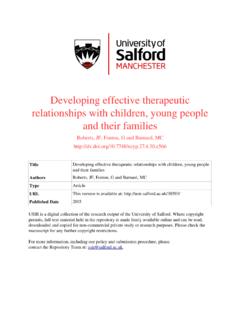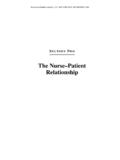Transcription of PRACTICE STANDARD Therapeutic Nurse-Client …
1 PR ACTICE STANDARD . Therapeutic Nurse-Client relationship , Revised 2006. Table of Contents Introduction 3. Components of the Nurse-Client relationship 3. Glossary 4. STANDARD Statements 5. 1) Therapeutic communication 5. 2) Client-centred care 6. 3) Maintaining boundaries 7. Giving and accepting gifts 8. 4) Protecting the client from abuse 9. How To Apply this STANDARD 11. Decision tree 11. Warning signs of crossing a boundary 12. When a colleague's behaviour crosses a boundary 12. Maintaining a Quality PRACTICE Setting 13. References 14. Suggested Reading 15. Appendix A: Abusive Behaviours 16.
2 Appendix B: Nursing a Family Member or Friend 17. VISION. Leading in regulatory excellence MISSION. Regulating nursing in the public interest Therapeutic Nurse-Client relationship , Revised 2006 Pub. No. 41033. ISBN 978-1-77116-060-5. Copyright College of Nurses of Ontario, 2017. Commercial or for-profit redistribution of this document in part or in whole is prohibited except with the written consent of CNO. This document may be reproduced in part or in whole for personal or educational use without permission, provided that: due diligence is exercised in ensuring the accuracy of the materials reproduced.
3 CNO is identified as the source; and the reproduction is not represented as an official version of the materials reproduced, nor as having been made in affiliation with, or with the endorsement of, CNO. First published March 1999 as STANDARD for the Therapeutic Nurse-Client relationship Reprinted January 2000, October 2000, October 2002. Reprinted January 2005 as Therapeutic Nurse-Client relationship Revised June 2006 as Therapeutic Nurse-Client relationship , Revised 2006. Reprinted May 2008. Updated June 2009. Updated footnote May 2013 (ISBN 1-897308-06-X). Updated February 2017.
4 Additional copies of this document may be obtained by contacting CNO's Customer Service Centre at 416 928-0900. or toll-free in Canada at 1 800 387-5526. College of Nurses of Ontario 101 Davenport Rd. Toronto, ON M5R 3P1. Ce fascicule existe en fran ais sous le titre : La relation th rapeutique, revis e 2006 no 51033. 3. PR ACTICE STANDARD . Nursing standards are expectations that contribute and attitudes required to practise safely;. to public protection. They inform nurses of their describe what each nurse is accountable for in accountabilities and the public of what to expect of PRACTICE ; and nurses.
5 Standards apply to all nurses regardless of their provide guidance in the interest of public role, job description or area of PRACTICE . protection. College of Nurses of Ontario Components of the Nurse-Client Introduction relationship At the core of nursing is the Therapeutic Nurse-Client There are five components to the Nurse-Client relationship . The nurse1 establishes and maintains relationship : trust, respect, professional intimacy, this key relationship by using nursing knowledge empathy and power. Regardless of the context, and skills, as well as applying caring attitudes and length of interaction and whether a nurse is behaviours.
6 Therapeutic nursing services contribute the primary or secondary care provider, these to the client's2 health and well-being. The components are always present. relationship is based on trust, respect, empathy and professional intimacy, and requires appropriate use Trust. Trust is critical in the Nurse-Client of the power inherent in the care provider's role. relationship because the client is in a vulnerable Initially, trust in a relationship is fragile, This document replaces the 1999 Therapeutic Nurse- so it's especially important that a nurse keep Client relationship PRACTICE STANDARD , and provides promises to a client.
7 If trust is breached, it becomes greater clarity and direction on: difficult to giving gifts to and receiving gifts from clients;. accepting power of attorney on behalf of clients; Respect. Respect is the recognition of the inherent setting appropriate boundaries for the dignity, worth and uniqueness of every individual, relationship ; regardless of socio-economic status, personal identifying and dealing effectively with attributes and the nature of the health unacceptable and/or abusive behaviour in nurse- client relationships; and Professional intimacy. Professional intimacy is exercising professional judgment when inherent in the type of care and services that nurses establishing, maintaining and terminating a provide.
8 It may relate to the physical activities, Therapeutic relationship . such as bathing, that nurses perform for, and with, the client that create closeness. Professional The College of Nurses of Ontario's (the College's) intimacy can also involve psychological, spiritual PRACTICE standards apply to all nurses, regardless of and social elements that are identified in the plan their role or PRACTICE area. The College publishes of care. Access to the client's personal information, PRACTICE standards to promote safe, effective, ethical within the meaning of the Freedom of Information care, and to: and Protection of Privacy Act, also contributes to outline the generally accepted expectations professional intimacy.
9 Of nurses and set out the professional basis of nursing PRACTICE ; Empathy. Empathy is the expression of provide a guide to the knowledge, skill, judgment understanding, validating and resonating with the 1 . In this document, nurse refers to a Registered Practical Nurse (RPN), Registered Nurse (RN) and Nurse Practitioner (NP). 2 . Bolded words are defined in the glossary on page 4. 3 . (Hupcey, Penrod, Morse & Mitcham, 2001). 4 . Based on a 1998 interview with Carla Peppler, NP, and Cheryl Forchuk, RN. 5 . (American Nurses Association, 2001; Milton, 2005). College of Nurses of Ontario PRACTICE STANDARD : Therapeutic Nurse-Client relationship , Revised 2006.
10 4. PR ACTICE STANDARD . meaning that the health care experience holds for significant The appropriate use of power, the client. In nursing, empathy includes appropriate in a caring manner, enables the nurse to partner emotional distance from the client to ensure with the client to meet the client's needs. A misuse objectivity and an appropriate professional of power is considered abuse. Power. The Nurse-Client relationship is one of Therapeutic Nurse-Client relationship , Revised 2006. unequal power. Although the nurse may not includes four STANDARD statements with indicators immediately perceive it, the nurse has more power that describe a nurse's accountabilities in the nurse- than the client.
